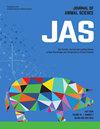PSLBI-17 Total sulfur amino acid requirements across the canine life cycle in Labrador Retrievers using the indicator amino acid oxidation (IAAO) technique
IF 2.7
2区 农林科学
Q1 AGRICULTURE, DAIRY & ANIMAL SCIENCE
引用次数: 0
Abstract
Methionine and cysteine are the principal sulfur-containing amino acids that are incorporated into proteins, although homocysteine and taurine also have important physiological roles in canines. As limited studies have been conducted for total sulfur-containing amino acids (TSAA) requirements across the canine life cycle, our objective was to determine the minimum requirements (MR) for TSAA at 4 life stages using the indicator amino acid oxidation (IAAO) technique. Labrador Retrievers (n = 24) were used in feeding studies to evaluate the changing requirements of TSAA as dogs mature: 6 puppies aged 10 to 14 wk, 6 puppies >14 wk to 9 mos, 6 adults 2 to 5 yr (yr), and 6 seniors > 8yr. Following a 2-d adaptation to a TSAA-adequate basal diet (TSAA = 1.12% dry matter), dogs underwent individual IAAO studies. In brief, all dogs were randomly fed one of six test diets with varying levels of TSAA ranging from deficient to sufficient (final TSAA content in experimental diets were 0.41, 0.46, 0.51, 0.98, 1.05, and 1.12% dry matter, with indispensable amino acids formulated at 1.6x NRC values). The test diet was divided into 13 equal meals; at the 5th meal, a tracer amino acid was included (a bolus L-[1-13C] phenylalanine based on body weight was first given, followed by [1-13C] Phe doses every 30 spanning 4 h). Breath samples were collected via a respiration mask every 30 min. Total CO2 production was determined via indirect calorimetry and production of 13CO2 at each dose was measured by enrichment of 13C in breath samples via isotope ratio mass spectrometry (IRMS). Results for IRMS data were converted to atom percent excess (APE) and analyzed using segmented linear regression. The Four Rivers mean and population requirements for TSAA were estimated to be 1.55 ± 0.069 g/1,000 kcal (mean ± 2 SD) for puppies 10 to 14 wk, 1.53 ± 0.21 g/1,000 kcal (mean ± 2 SD) for puppies 14 wk to 9 mo, 1.4 ± 0.30 g/1000 kcal (mean ± 2 SD) for adults 2 to 5 yr, and 1.27 ± 0.23 g/1,000 kcal (mean ± 2 SD) for seniors. These results may contribute to the formulation of diets that meet the age-appropriate requirements of TSAA for large-breed dogs at all life stages.PSLBI-17 利用指示性氨基酸氧化(IAAO)技术测定拉布拉多寻回犬在整个犬类生命周期中对总硫氨基酸的需求量
蛋氨酸和半胱氨酸是蛋白质中的主要含硫氨基酸,尽管同型半胱氨酸和牛磺酸在犬中也有重要的生理作用。由于针对犬类整个生命周期对总含硫氨基酸(TSAA)需求量的研究有限,我们的目标是利用指示氨基酸氧化(IAAO)技术确定犬类在 4 个生命阶段对总含硫氨基酸的最低需求量(MR)。拉布拉多猎犬(n = 24)被用于喂养研究,以评估狗在成熟过程中对 TSAA 需求量的变化:6 只 10 到 14 周岁的幼犬、6 只 14 到 9 周岁的幼犬、6 只 2 到 5 岁的成年犬和 6 只 8 岁的老年犬。 在对 TSAA 充足的基础日粮(TSAA = 1.12% 干物质)进行 2 天适应后,狗进行了单独的 IAAO 研究。简而言之,所有狗都被随机喂食六种试验日粮中的一种,这些日粮的 TSAA 含量从缺乏到充足不等(试验日粮中的最终 TSAA 含量分别为 0.41、0.46、0.51、0.98、1.05 和 1.12%(干物质),其中不可缺少的氨基酸按 1.6 倍 NRC 值配制)。试验日粮分为 13 餐;在第 5 餐中加入示踪氨基酸(首先根据体重注射 L-[1-13C]苯丙氨酸,然后每隔 30-4 小时注射一次[1-13C]Phe)。每隔 30 分钟通过呼吸面罩收集一次呼吸样本。通过间接量热法测定二氧化碳的总产生量,并通过同位素比质谱法(IRMS)富集呼气样本中的 13C 来测定每个剂量下 13CO2 的产生量。IRMS 数据的结果被转换为原子过量百分比 (APE),并使用分段线性回归法进行分析。据估计,10 至 14 周幼犬的四河平均值和人群对 TSAA 的需求量为 1.55 ± 0.069 g/1,000 kcal(平均值 ± 2 SD),14 周至 9 月幼犬为 1.53 ± 0.21 g/1,000 kcal(平均值 ± 2 SD),2 至 5 岁成年人为 1.4 ± 0.30 g/1,000 kcal(平均值 ± 2 SD),老年人为 1.27 ± 0.23 g/1,000 kcal(平均值 ± 2 SD)。这些结果可能有助于配制符合大型犬各年龄阶段对 TSAA 需求的日粮。
本文章由计算机程序翻译,如有差异,请以英文原文为准。
求助全文
约1分钟内获得全文
求助全文
来源期刊

Journal of animal science
农林科学-奶制品与动物科学
CiteScore
4.80
自引率
12.10%
发文量
1589
审稿时长
3 months
期刊介绍:
The Journal of Animal Science (JAS) is the premier journal for animal science and serves as the leading source of new knowledge and perspective in this area. JAS publishes more than 500 fully reviewed research articles, invited reviews, technical notes, and letters to the editor each year.
Articles published in JAS encompass a broad range of research topics in animal production and fundamental aspects of genetics, nutrition, physiology, and preparation and utilization of animal products. Articles typically report research with beef cattle, companion animals, goats, horses, pigs, and sheep; however, studies involving other farm animals, aquatic and wildlife species, and laboratory animal species that address fundamental questions related to livestock and companion animal biology will be considered for publication.
 求助内容:
求助内容: 应助结果提醒方式:
应助结果提醒方式:


